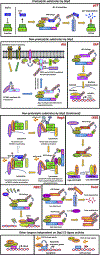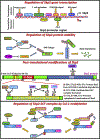The Skp2 Pathway: A Critical Target for Cancer Therapy
- PMID: 32014608
- PMCID: PMC9201937
- DOI: 10.1016/j.semcancer.2020.01.013
The Skp2 Pathway: A Critical Target for Cancer Therapy
Abstract
Strictly regulated protein degradation by ubiquitin-proteasome system (UPS) is essential for various cellular processes whose dysregulation is linked to serious diseases including cancer. Skp2, a well characterized component of Skp2-SCF E3 ligase complex, is able to conjugate both K48-linked ubiquitin chains and K63-linked ubiquitin chains on its diverse substrates, inducing proteasome mediated proteolysis or modulating the function of tagged substrates respectively. Overexpression of Skp2 is observed in various human cancers associated with poor survival and adverse therapeutic outcomes, which in turn suggests that Skp2 engages in tumorigenic activity. To that end, the oncogenic properties of Skp2 are demonstrated by various genetic mouse models, highlighting the potential of Skp2 as a target for tackling cancer. In this article, we will describe the downstream substrates of Skp2 as well as upstream regulators for Skp2-SCF complex activity. We will further summarize the comprehensive oncogenic functions of Skp2 while describing diverse strategies and therapeutic platforms currently available for developing Skp2 inhibitors.
Keywords: Skp2-SCF complex; cancer targeting; ubiquitination.
Copyright © 2020. Published by Elsevier Ltd.
Figures
Similar articles
-
Regulation of Skp2 expression and activity and its role in cancer progression.ScientificWorldJournal. 2010 Jun 1;10:1001-15. doi: 10.1100/tsw.2010.89. ScientificWorldJournal. 2010. PMID: 20526532 Free PMC article. Review.
-
Novel roles of Skp2 E3 ligase in cellular senescence, cancer progression, and metastasis.Chin J Cancer. 2012 Apr;31(4):169-77. doi: 10.5732/cjc.011.10319. Epub 2011 Dec 23. Chin J Cancer. 2012. PMID: 22200179 Free PMC article. Review.
-
The role of Skp2 and its substrate CDKN1B (p27) in colorectal cancer.J Gastrointestin Liver Dis. 2015 Jun;24(2):225-34. doi: 10.15403/jgld.2014.1121.242.skp2. J Gastrointestin Liver Dis. 2015. PMID: 26114183 Review.
-
The SCF-type E3 Ubiquitin Ligases as Cancer Targets.Curr Cancer Drug Targets. 2016;16(2):119-29. doi: 10.2174/1568009616666151112122231. Curr Cancer Drug Targets. 2016. PMID: 26560120 Review.
-
Estrogen and progesterone regulate p27kip1 levels via the ubiquitin-proteasome system: pathogenic and therapeutic implications for endometrial cancer.PLoS One. 2012;7(9):e46072. doi: 10.1371/journal.pone.0046072. Epub 2012 Sep 27. PLoS One. 2012. PMID: 23029392 Free PMC article.
Cited by
-
SCF-SKP2 E3 ubiquitin ligase links mTORC1/ER stress/ISR with YAP activation in murine renal cystogenesis.J Clin Invest. 2022 Dec 15;132(24):e153943. doi: 10.1172/JCI153943. J Clin Invest. 2022. PMID: 36326820 Free PMC article.
-
Elucidating Differences in Early-Stage Centrosome Amplification in Primary and Immortalized Mouse Cells.Int J Mol Sci. 2023 Dec 27;25(1):383. doi: 10.3390/ijms25010383. Int J Mol Sci. 2023. PMID: 38203554 Free PMC article.
-
Suppression of Skp2 contributes to sepsis-induced acute lung injury by enhancing ferroptosis through the ubiquitination of SLC3A2.Cell Mol Life Sci. 2024 Jul 30;81(1):325. doi: 10.1007/s00018-024-05348-3. Cell Mol Life Sci. 2024. PMID: 39079969 Free PMC article.
-
G1 Dynamics at the Crossroads of Pluripotency and Cancer.Cancers (Basel). 2023 Sep 14;15(18):4559. doi: 10.3390/cancers15184559. Cancers (Basel). 2023. PMID: 37760529 Free PMC article. Review.
-
Overview of distinct N6-Methyladenosine profiles of messenger RNA in osteoarthritis.Front Genet. 2023 May 9;14:1168365. doi: 10.3389/fgene.2023.1168365. eCollection 2023. Front Genet. 2023. PMID: 37229206 Free PMC article.
References
-
- Wilkinson KD, Protein ubiquitination: a regulatory post-translational modification, Anti-cancer drug design 2 (2) (1987) 211–229. - PubMed
-
- Vucic D, Dixit VM, Wertz IE, Ubiquitylation in apoptosis: a post-translational modification at the edge of life and death, Nature reviews, Molecular cell biology 12 (7) (2011) 439–452. - PubMed
-
- Nakayama KI, Nakayama K, Ubiquitin ligases: cell-cycle control and cancer, Nature reviews, Cancer 6 (5) (2006) 369–381. - PubMed
Publication types
MeSH terms
Substances
Grants and funding
LinkOut - more resources
Full Text Sources
Other Literature Sources
Medical
Molecular Biology Databases
Miscellaneous






